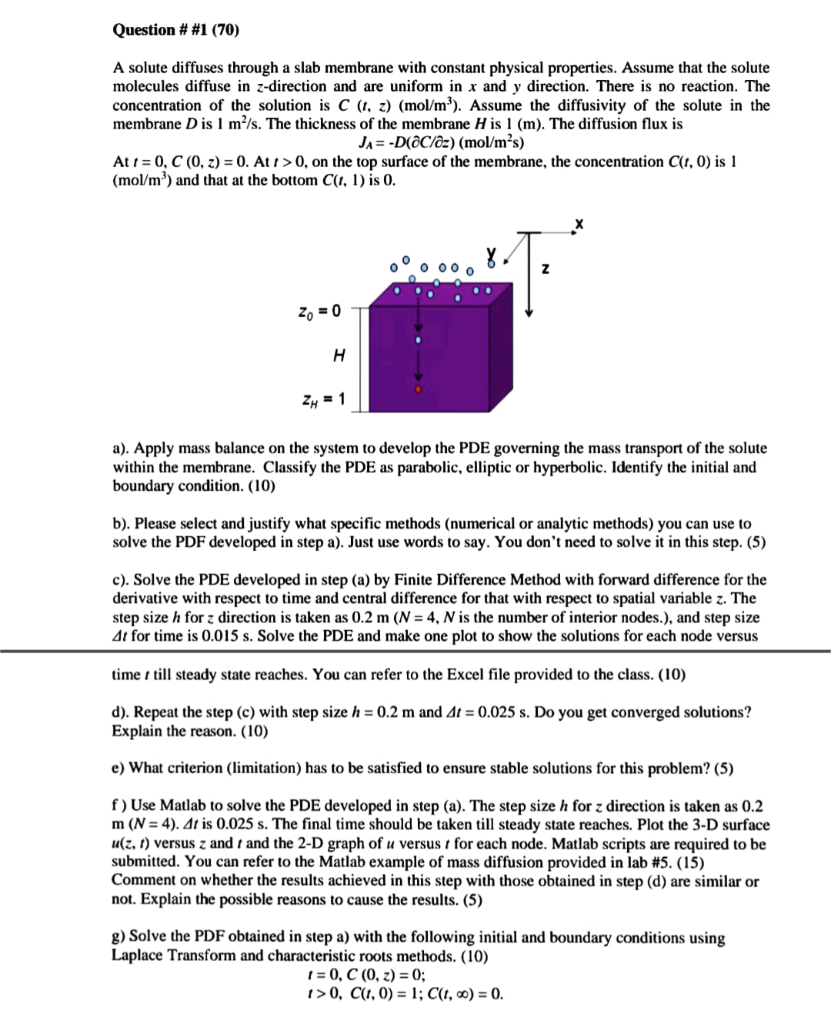
A solute diffuses through a slab membrane with constant physical properties. Assume that the solute molecules diffuse in z-direction and are uniform in x and y direction. There is no reaction. The concentration of the solution is C(t,z)(mol/m3). Assume the diffusivity of the solute in the membrane D is 1m2/s. The thickness of the membrane H is 1(m). The diffusion flux is JA=D(C/z)(mol/m2s) At t=0,C(0,z)=0. At t>0, on the top surface of the membrane, the concentration C(t,0) is 1 (mol/m3) and that at the bottom C(t,1) is 0 . a). Apply mass balance on the system to develop the PDE governing the mass transport of the solute within the membrane. Classify the PDE as parabolic, elliptic or hyperbolic. Identify the initial and boundary condition. (10) b). Please select and justify what specific methods (numerical or analytic methods) you can use to solve the PDF developed in step a). Just use words to say. You don't need to solve it in this step. (5) c). Solve the PDE developed in step (a) by Finite Difference Method with forward difference for the derivative with respect to time and central difference for that with respect to spatial variable z. The step size h for z direction is taken as 0.2m(N=4,N is the number of interior nodes.), and step size t for time is 0.015s. Solve the PDE and make one plot to show the solutions for each node versus time t till steady state reaches. You can refer to the Excel file provided to the class. (10) d). Repeat the step (c) with step size h=0.2m and t=0.025s. Do you get converged solutions? Explain the reason. (10) e) What criterion (limitation) has to be satisfied to ensure stable solutions for this problem? (5) f) Use Matlab to solve the PDE developed in step (a). The step size h for z direction is taken as 0.2 m(N=4).t is 0.025s. The final time should be taken till steady state reaches. Plot the 3-D surface u(z,t) versus z and t and the 2-D graph of u versus t for each node. Matlab scripts are required to be submitted. You can refer to the Matlab example of mass diffusion provided in lab \#5. (15) Comment on whether the results achieved in this step with those obtained in step (d) are similar or not. Explain the possible reasons to cause the results. (5) g) Solve the PDF obtained in step a) with the following initial and boundary conditions using Laplace Transform and characteristic roots methods. (10) t=0,C(0,z)=0;t>0,C(t,0)=1;C(t,)=0. A solute diffuses through a slab membrane with constant physical properties. Assume that the solute molecules diffuse in z-direction and are uniform in x and y direction. There is no reaction. The concentration of the solution is C(t,z)(mol/m3). Assume the diffusivity of the solute in the membrane D is 1m2/s. The thickness of the membrane H is 1(m). The diffusion flux is JA=D(C/z)(mol/m2s) At t=0,C(0,z)=0. At t>0, on the top surface of the membrane, the concentration C(t,0) is 1 (mol/m3) and that at the bottom C(t,1) is 0 . a). Apply mass balance on the system to develop the PDE governing the mass transport of the solute within the membrane. Classify the PDE as parabolic, elliptic or hyperbolic. Identify the initial and boundary condition. (10) b). Please select and justify what specific methods (numerical or analytic methods) you can use to solve the PDF developed in step a). Just use words to say. You don't need to solve it in this step. (5) c). Solve the PDE developed in step (a) by Finite Difference Method with forward difference for the derivative with respect to time and central difference for that with respect to spatial variable z. The step size h for z direction is taken as 0.2m(N=4,N is the number of interior nodes.), and step size t for time is 0.015s. Solve the PDE and make one plot to show the solutions for each node versus time t till steady state reaches. You can refer to the Excel file provided to the class. (10) d). Repeat the step (c) with step size h=0.2m and t=0.025s. Do you get converged solutions? Explain the reason. (10) e) What criterion (limitation) has to be satisfied to ensure stable solutions for this problem? (5) f) Use Matlab to solve the PDE developed in step (a). The step size h for z direction is taken as 0.2 m(N=4).t is 0.025s. The final time should be taken till steady state reaches. Plot the 3-D surface u(z,t) versus z and t and the 2-D graph of u versus t for each node. Matlab scripts are required to be submitted. You can refer to the Matlab example of mass diffusion provided in lab \#5. (15) Comment on whether the results achieved in this step with those obtained in step (d) are similar or not. Explain the possible reasons to cause the results. (5) g) Solve the PDF obtained in step a) with the following initial and boundary conditions using Laplace Transform and characteristic roots methods. (10) t=0,C(0,z)=0;t>0,C(t,0)=1;C(t,)=0







